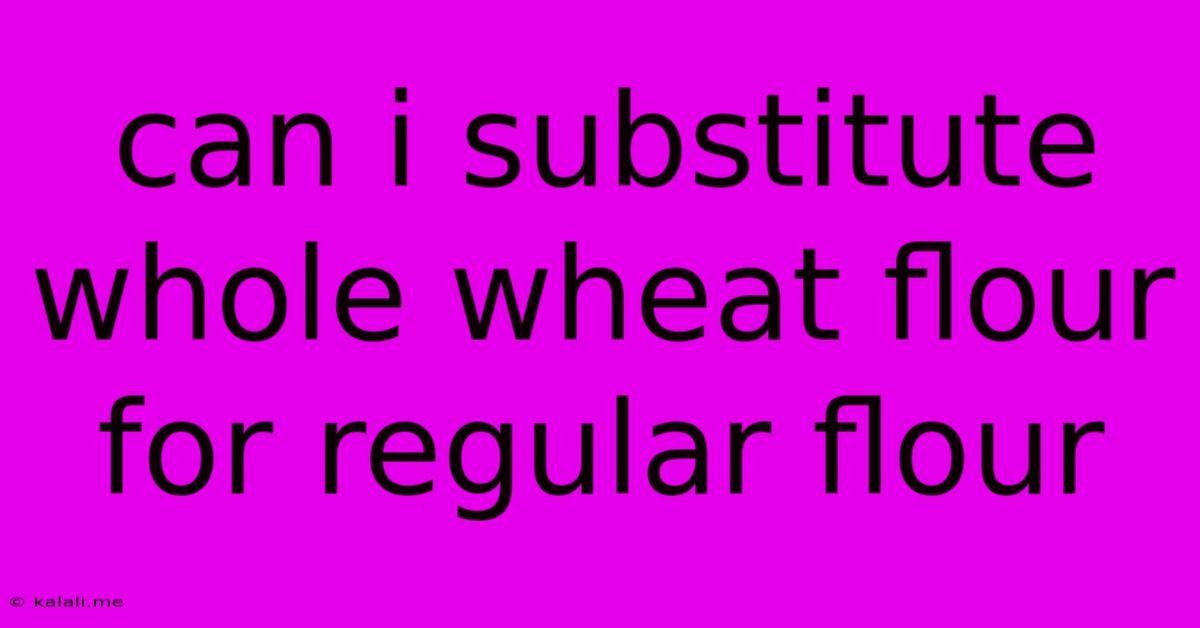Can I Substitute Whole Wheat Flour For Regular Flour
Kalali
Jun 05, 2025 · 3 min read

Table of Contents
Can I Substitute Whole Wheat Flour for Regular Flour? A Baker's Guide
Meta Description: Wondering if you can swap whole wheat flour for all-purpose flour? This guide explores the possibilities, benefits, and challenges of this substitution, offering tips for successful baking.
Substituting whole wheat flour for all-purpose flour is a common question among bakers, particularly those aiming for a healthier and more nutritious baked good. The short answer is: yes, you can, but it's not always a simple one-to-one swap. The success of your substitution depends on several factors, including the recipe, the type of whole wheat flour used, and your baking technique.
Understanding the Differences
The key difference lies in the composition of the flours. All-purpose flour, primarily made from the endosperm of the wheat kernel, is relatively low in fiber and bran. This gives it a finer texture and makes it easier to work with. Whole wheat flour, on the other hand, includes the entire wheat kernel – the bran, germ, and endosperm. This results in a higher fiber content, a coarser texture, and a nuttier flavor. The bran and germ also contain oils that can affect the dough's moisture and gluten development.
The Challenges of Substitution
The increased fiber content in whole wheat flour leads to several challenges:
- Denser Texture: Baked goods made with whole wheat flour tend to be denser and less fluffy than those made with all-purpose flour. This is because the bran particles interfere with gluten development.
- Dryer Texture: The bran absorbs more liquid, potentially leading to a drier final product.
- Stronger Flavor: The nuttier flavor of whole wheat flour might not complement all recipes. It can overpower delicate flavors.
- Browner Color: Whole wheat flour naturally results in a darker, browner baked good.
Tips for Successful Substitution
While challenges exist, you can successfully substitute whole wheat flour with careful planning:
- Start Small: Begin by replacing only a portion of the all-purpose flour with whole wheat flour. A good starting point is a 25% substitution (e.g., replace 1/4 cup all-purpose flour with 1/4 cup whole wheat flour).
- Adjust Liquid: Whole wheat flour absorbs more liquid. You might need to add 1-2 tablespoons of liquid at a time until you achieve the desired dough consistency.
- Add Vital Wheat Gluten (Optional): To compensate for the reduced gluten development, you can add vital wheat gluten. This will help improve the texture and rise of your baked goods. Follow package instructions for the appropriate amount.
- Choose the Right Whole Wheat Flour: Different types of whole wheat flour exist. Some are finer than others, leading to varied results. Experiment to find what works best for your recipe.
- Experiment: Baking is an iterative process. Don't be afraid to experiment and adjust the recipe based on your results.
Recipes that Handle Whole Wheat Flour Well
Some recipes naturally lend themselves better to whole wheat flour substitutions:
- Quick Breads: Muffins, scones, and banana bread often benefit from the added texture and nutty flavor of whole wheat flour.
- Hearty Breads: Loaves of bread designed for a denser crumb already accommodate whole wheat flour well.
- Cookies: Some cookies, particularly those with oats or nuts, can tolerate a partial substitution without significant changes in texture.
Conclusion
Substituting whole wheat flour for all-purpose flour can be a rewarding way to add nutrients and a unique flavor to your baked goods. While it requires some adjustments and experimentation, with careful planning and the tips mentioned above, you can achieve delicious and successful results. Remember to start small, adjust the liquid, and don't be discouraged if your first attempts aren't perfect. The journey of baking is all about learning and refining your skills!
Latest Posts
Latest Posts
-
I Can Relate With The Commoners
Jun 07, 2025
-
How To Keep Spices From Clumping
Jun 07, 2025
-
What Was In The Arc Of The Covenant
Jun 07, 2025
-
Can I Manually Closer Ac Damper
Jun 07, 2025
-
Did You Hear About The Magic Tractor
Jun 07, 2025
Related Post
Thank you for visiting our website which covers about Can I Substitute Whole Wheat Flour For Regular Flour . We hope the information provided has been useful to you. Feel free to contact us if you have any questions or need further assistance. See you next time and don't miss to bookmark.